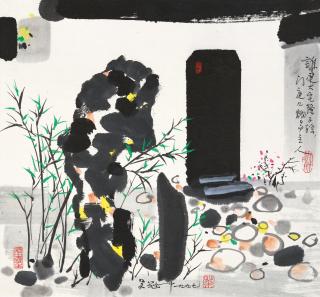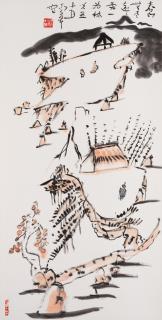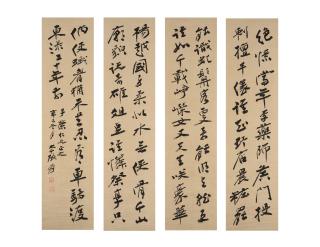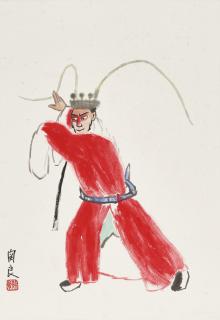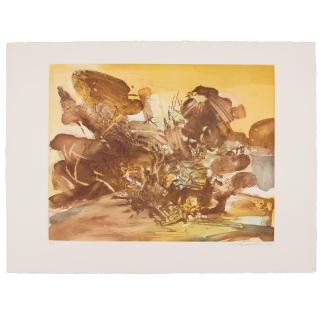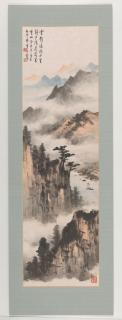Wu Guanzhong 1919 - 2010
The artist Wu Guanzhong
- Contemporary Chinese artist who studied in Paris and among other places.
- Widely recognised as the founder of modern Chinese painting.
- Known for his landscape paintings in which he combines ink and oil painting.
Born on 29.06.1919 in Jiangsu Province, China, Wu Guanzhong was a contemporary artist widely recognised as the founder of modern Chinese painting. Through the influence of Zhu Dequn (also Chu Teh-Chun), he entered the Hangzhou National Academy of Art in 1936, where he studied both Chinese and Western painting under Pan Tianshou, Lin Fengmian and Wu Dayu, among others. Thanks to a scholarship, he moved to Paris in 1947, where he studied art for three years at the renowned École nationale supérieure des Beaux-Arts. This stay and the contact with Western art had a lasting influence on Wu.
After returning to China in 1950, he taught at various Chinese art colleges before being banned from teaching, painting and writing with the start of the cultural revolution in 1966. In addition, many of his early works were destroyed and Wu was assigned to two years of forced labour in the countryside as part of communist Mao's »re-education through labour« initiative. It was not until the early 1980s that Wu was able to paint freely again.
In 1992, the British Museum in London dedicated a solo exhibition to him, making him the first living Chinese artist to receive this recognition. Today, his works are in the collections of the Spencer Museum of Art in Lawrence (Kansas), the National Gallery Singapore and the Metropolitan Museum of Art (New York City), among others. Wu Guanzhong died in Beijing on 25 June 2010 at the age of 90.
Artistically, Wu Guanzhong is best known for his landscape paintings, in which he combined Far Eastern ink painting and calligraphy with Western oil painting. He reduced the natural scenery to the essentials and used simple but powerful abstract forms. In addition to land and water landscapes, Wu devoted himself to many other aspects of China, including architecture, plants, animals and people. His stay in France and the works of greats such as Maurice Utrillo, Georges Braque, Henri Matisse, Paul Cézanne, Pablo Picasso and Vincent van Gogh strongly influenced Wu, so it is not surprising that his style is reminiscent of the Impressionist painting of the early 1900s.
Der Künstler Wu Guanzhong
- Zeitgenössischer chinesischer Künstler der u.a. in Paris studierte.
- Weithin als Begründer der modernen chinesischen Malerei anerkannt.
- Bekannt für seine Landschaftsbilder, in denen er Tusche- mit Ölmalerei kombiniert.
Der am 29.06.1919 in der Provinz Jiangsu (China) geborene Wu Guanzhong war ein zeitgenössischer Künstler, der weithin als Begründer der modernen chinesischen Malerei anerkannt ist. Durch den Einfluss von Zhu Dequn (auch Chu Teh-Chun) ging er 1936 an die Nationale Kunstakademie von Hangzhou, wo er sowohl chinesische als auch westliche Malerei u. a. unter Pan Tianshou, Lin Fengmian und Wu Dayu studierte. Dank eines Stipendiums verschlug es ihn 1947 nach Paris, wo er für drei Jahre an der renommierten École nationale supérieure des Beaux-Arts Kunst studierte. Dieser Aufenthalt und der Kontakt mit westlicher Kunst hatten einen nachhaltigen Einfluss auf Wu.
Nach seiner Rückkehr nach China 1950 lehrte er an verschiedenen chinesischen Kunsthochschulen, bevor ihm mit Beginn der kulturellen Revolution 1966 das Lehren, Malen und Schreiben verboten wurden. Darüber hinaus wurden viele seiner Frühwerke zerstört und Wu im Rahmen der Initiative des kommunistischen Maos zur »Umerziehung durch Arbeit« zu zwei Jahren Zwangsarbeit auf dem Lande abkommandiert. Erst zu Beginn der 1980er war es Wu wieder möglich, frei zu malen.
1992 widmete das Britische Museum in London ihm eine Einzelausstellung und machte ihn damit zum ersten lebenden chinesischen Künstler, dem diese Ehre zuteilwurde. Heute befinden sich seine Werke unter anderem in den Sammlungen des Spencer Museum of Art in Lawrence (Kansas), der National Gallery Singapore und des Metropolitan Museum of Art (New York City). Wu Guanzhong starb am 25.06.2010 im Alter von 90 Jahren in Peking.
Künstlerisch ist Wu Guanzhong vor allem für seine Landschaftsbilder bekannt, in denen er fernöstliche Tuschemalerei sowie Kalligrafie mit westlicher Ölmalerei kombinierte. Die Naturkulisse hat der dabei auf das Wesentliche reduziert und einfache, aber kraftvolle abstrakte Formen genutzt. Neben Land- und Wasserlandschaften widmete sich Wu vielen weiteren Aspekten Chinas, darunter Architektur, Pflanzen, Tiere und Menschen. Sein Aufenthalt in Frankreich und die Werke von Größen wie Maurice Utrillo, Georges Braque, Henri Matisse, Paul Cézanne, Pablo Picasso und Vincent van Gogh haben Wu stark beeinflusst und so wundert es nicht, dass sein Stil an die impressionistische Malerei der frühen 1900er Jahre erinnert.



